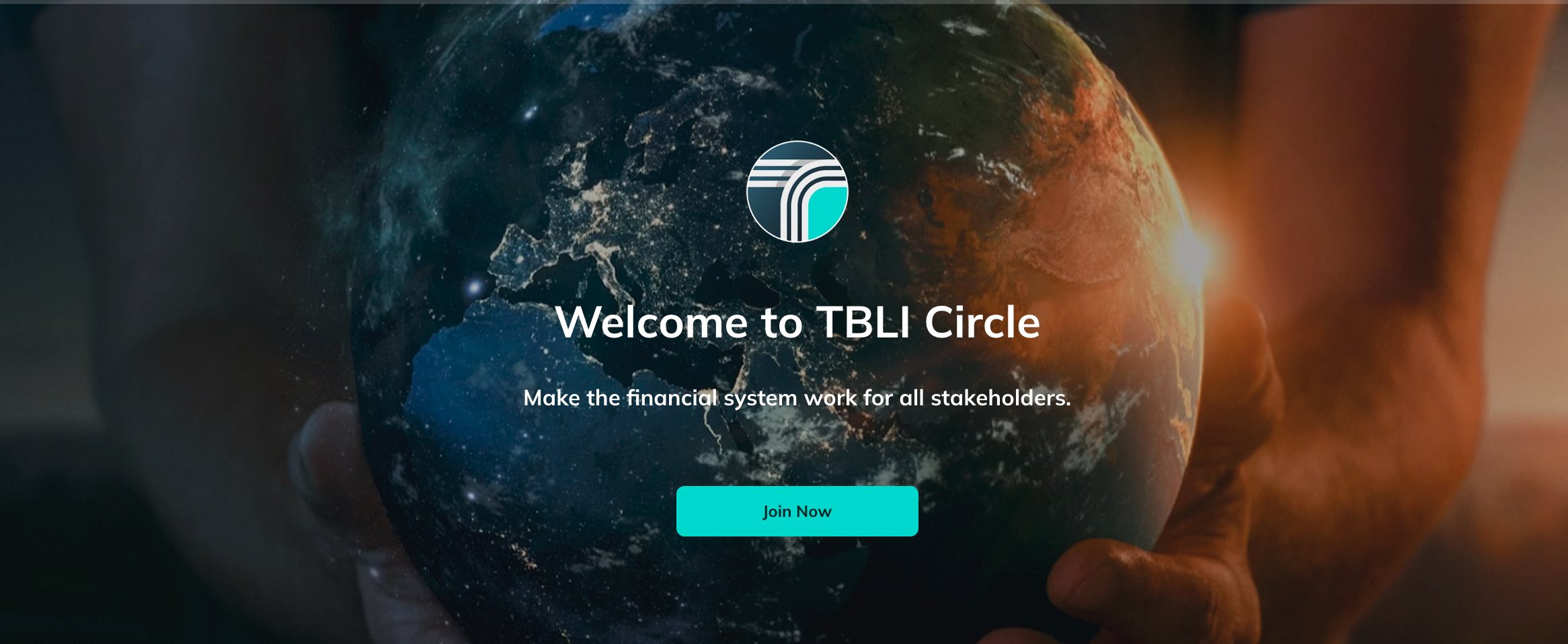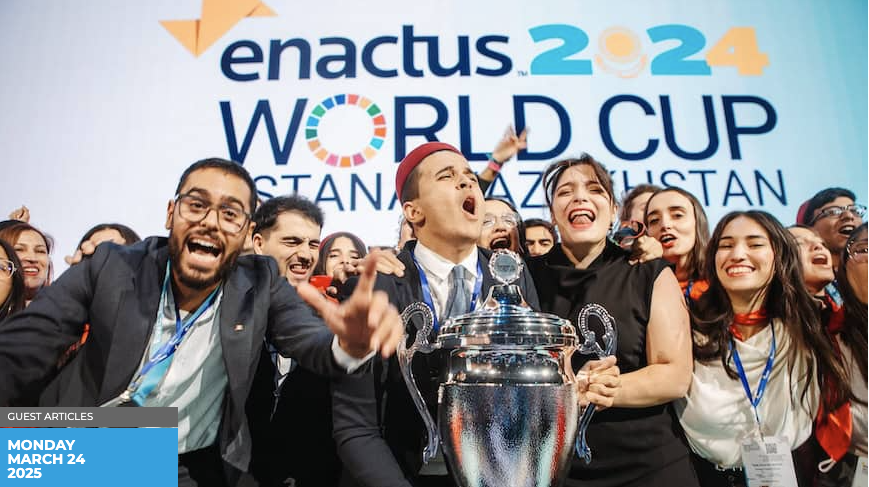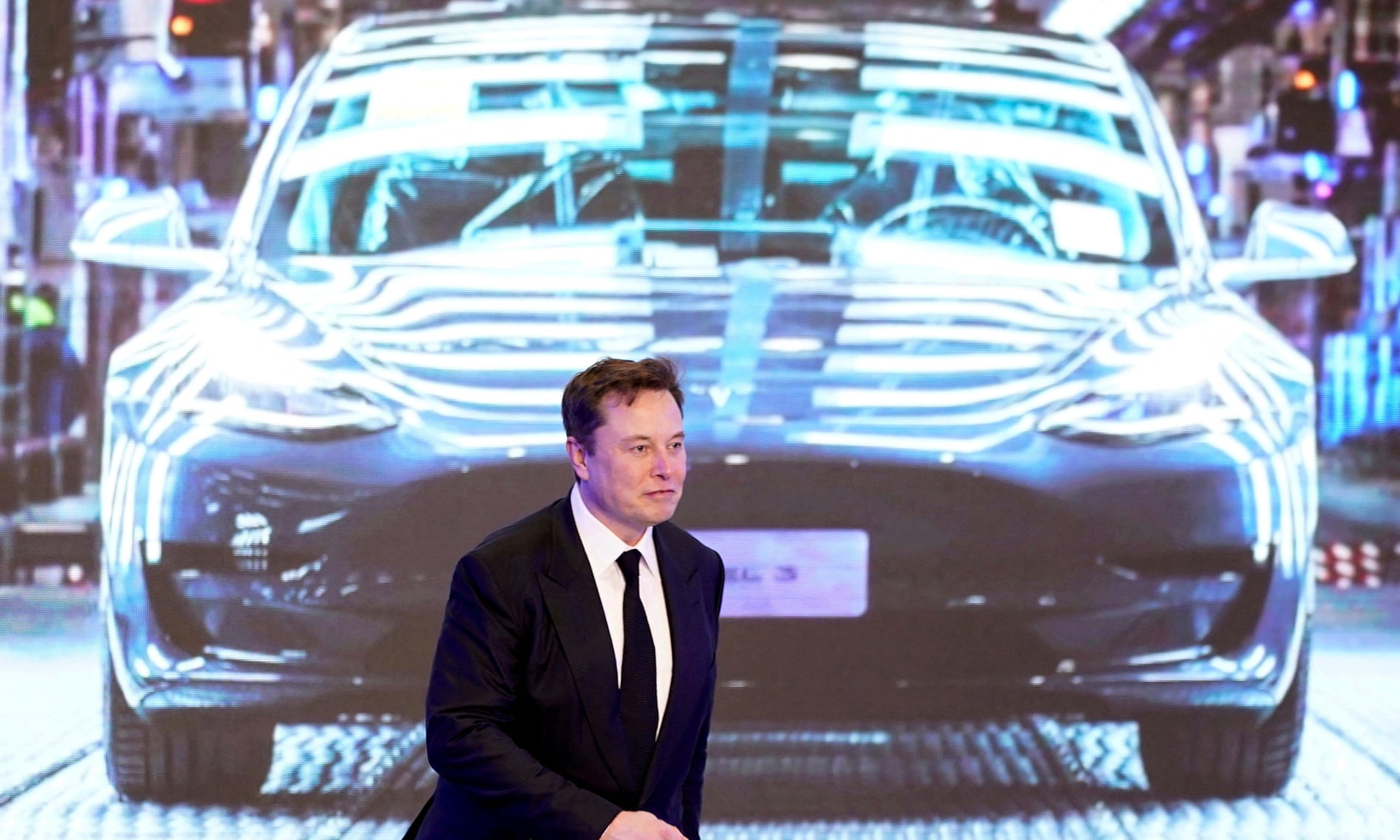
Your weekly guide to Sustainable Investment
TBLI Capital Connect
Your Gateway to Mission-Aligned Investors
Why TBLI Capital Connect?
✅ Access to a curated network of high-net-worth investors and venture capitalists
✅ Tailored matchmaking to align you with the right funding partners
✅ Streamlined process to fast-track your fundraising goals
✅ Different tiers of service, offering you the most suitable service according to your budget.
More details here
Would you like to book a call to discuss in detail? click here
Upcoming TBLI Virtual Mixers
TBLI Radical Truth Podcast
Reimagining Economics for a Just Future /w Rob Johnson
Today we're honored to welcome Rob Johnson, President of the Institute for New Economic Thinking (INET), which he co-founded with George Soros, William Janeway, and James Balsillie in 2009. Rob stands at the forefront of efforts to reshape economic theory and practice for a more equitable and sustainable world.
Under his leadership, INET has become a powerful catalyst for fresh perspectives that address our most pressing economic challenges - from inequality and climate change to financial instability and democratic erosion.
In this episode, "Reimagining Economics for a Just Future," we'll explore how new economic thinking can help create financial systems that serve humanity rather than the other way around. Rob brings insights from his decades of experience challenging economic orthodoxy and building bridges between academia, policy, and real-world practice.
Join TBLI Circle and expand your Impact network

Step into a community of purpose-driven professionals transforming finance for a sustainable future. At TBLI Circle, you’ll connect with authentic leaders, discover breakthrough opportunities, and gain insights that drive real impact. Expand your network, elevate your influence, and accelerate your journey in ESG and impact investing. Don’t just talk about change—be the change.
Expand your network, elevate your influence, and accelerate your journey in ESG and impact investing. Don’t just talk about change—be the change.
Environmentalists in Israel and Palestine fight to save cross-border water resources

"The health of Palestinians affects the health of Israelis and vice versa. And the best example is water."
Wadi Gaza is the estuary of Nahal Besor, a stream mentioned in the Bible. It flows west from Hebron in the West Bank, through Israeli territory and on through Gaza into the Mediterranean Sea. Today, after 18 months of war, Wadi Gaza is characterized by “pollution from debris, wastewater, corpses, ammunition, and explosives,” in the words of Nada Majdalani, the Palestinian director of EcoPeace Middle East.
Nevertheless, spring is still the migration season in Israel and Palestine. This region forms a narrow land bridge joining Europe, Asia, and Africa, marking one of the world’s busiest flight paths for an estimated 500 million birds. Many of them — flamingos, herons, storks, cranes — land in Wadi Gaza, one of the few natural preserves in the Gaza Strip, which grew into one of the most densely populated areas in the world over the last two decades because of Israeli restrictions.
This is the driest region in the world for the number of people it supports, and water scarcity is getting worse because it’s also warming around twice as fast as the global average. Eighty percent of Israel’s drinking water comes from ocean desalination. In Gaza, seawater intrusion has contaminated once-abundant underground reservoirs because of overpumping. While Israel and other powers in the region continue to practice resource hoarding and ecological destruction, there is also a small, stubborn movement of transboundary environmentalist peacebuilders, who have persisted throughout the current war.
Organizations like EcoPeace, the Arava Institute for Environmental Studies, and A Land For All — all three with shared Palestinian and Israeli leadership — have been working collectively for decades toward a vision that centers fair, shared stewardship of natural resources and sustainable development as the basis of lasting peace. And they persevere even now, after Israel violated a several-week ceasefire in March with another round of bombings, killings, and cutting off of aid to Gaza, and when the prevailing political messaging, according to Arava’s Barak Talmor, “has gotten so polarized that cultivating empathy or sympathy between the sides is increasingly challenging.”
Water-based environmental and health risks travel across borders, just like Nahal Besor. Yasmeen Abu Fraiha, an Israeli citizen and doctor of Palestinian descent, advises A Land For All, a political group that advocates for a two-state confederation. She was working at a hospital in southern Israel in the first few months of the war. There, she treated Israeli soldiers suffering from dysentery and rare fungal infections attributable to drinking the water in Gaza. “In Israel and Palestine, what we see is that our lives are so intertwined with each other,” she said. “The health of Palestinians affects the health of Israelis and vice versa. And the best example is water.”
This fact can sometimes force compromise. The environmental nonprofit EcoPeace Middle East was able to leverage the health-water connection to bring modern wastewater treatment to Gaza before the war. EcoPeace had Israeli beaches tested just north of Gaza, and found e.coli contamination in the sand. A technician at the lab also tipped them off that untreated solid waste from Gaza was clogging and shutting down an Israeli desalination facility.
“[Prime Minister Benjamin] Netanyahu himself quoted one of our reports in a statement in 2014, saying that if the sewage crisis of Gaza threatens Israel’s water security, we have to deal with it,” said Gidon Bromberg, EcoPeace’s Israeli co-founder and co-director. Four plants ultimately opened in Gaza by 2022, enabling Gazans and Israelis alike to more safely swim in the ocean; they sustained severe damage during the war.
Even after the October 7 attack of Hamas on Israel, Bromberg said, they were able to invoke the same principle of shared health destiny after Israel shut off the three water pipes supplying Gaza’s highest-quality drinking water. EcoPeace got leading Israeli public health experts to sign a letter saying, “You’re going to see lots of disease, and it’s not going to just stop in Gaza.”
“That was very effective,” he said. “It broadens the zero-sum thinking into an understanding that this is lose-lose.”
Within the first week, one drinking water pipeline was reopened, and eventually all three. (More recently, in March 2025, Israel cut power to two of Gaza’s desalination plants, once again imposing water scarcity as a weapon; EcoPeace is responding by lobbying the government).
Read full article
Pressure builds on European ESG funds to be less cautious on defence

Shifting political sentiment, growing financial returns and regulatory statements are all pushing sustainable fund managers to increase defence investing
“There is nothing in our rules, including those related to sustainability, that prevents investment or finance for defence companies,” was the clear message from the UK’s Financial Conduct Authority last week.
This echoes guidance issued by the European Commission in October 2023, which stated: “The EU sustainable finance framework . . . does not impose any limitations to the financing of any specific sector, including the defence sector.”
Many environmental, social and governance funds do not have any specific exclusion criteria around defence investing, apart from excluding so-called “controversial” weapons. In practice, however, many sustainable fund managers have been cautious about investing in defence stocks, says Aliénor Legendre, ESG research associate at sustainability investment advisory company MainStreet Partners.
Analysis by the company found 28 per cent of EU funds it defines as “ESG funds” are exposed to defence companies engaged in “conventional” weapons activities. For UK funds, the figures are similar, with 32 per cent of the ESG strategies it analysed investing in defence stocks.
Legendre suggests the main reasons for funds taking a cautious approach are concerns about reputation, human rights, regulatory clarity and the often high-carbon footprint of defence companies, meaning they are excluded based on funds’ environmental criteria.
Is defence a sustainability issue?
However, with increased calls in Europe for higher defence investment, companies are coming under pressure to be more bullish. The UK government, the European Commission and various EU member states have all recently initiated plans to boost defence investment significantly, given the increasingly unstable geopolitical climate.
Against a backdrop of growing concerns about European security, the question of whether protecting national security and sovereignty is also a question of sustainability is raising its head.
In the UK, MPs Alex Baker and Luke Charters wrote an open letter earlier this month urging UK fund managers and banks to “rethink ESG mechanisms that often wrongly exclude all defence investment as ‘unethical’”. Their letter suggests there is “no more ethical investment” than supporting Ukraine’s defence and stresses the important role funds can play in boosting the UK’s ability to defend itself.
“A robust defence sector is necessary to provide the means for national and regional security policies and to support economic and social stability,” argues Matt Christensen, global head of sustainable and impact investing at Allianz Global Investors, in a recent briefing note on reconciling defence investment with sustainability considerations.
Sustainable Views approached industry body the Principles for Responsible Investment for its views. It was not able to offer a concrete position. But in a statement, its head of human rights, social and governance issues, Remi Fernandez, said it was reviewing its guidance on this “fast-evolving issue . . . in light of the rapidly shifting external landscape”.
Andrew Ninian, director for stewardship and corporate governance at trade body the Investment Association, agrees that in the past year “there has been a lot more discussion around the idea that upholding freedom is a critical issue, and the extent to which defence investing supports that”.
He suggests it is primarily a question for fund industry clients to ask themselves. “Ultimately, people will take different views on that, and clients will have differing preferences about how they want their money to be invested, he says. “The industry’s role is to provide clients with different options to enable them to invest in line with their beliefs and priorities.”
Read full article
The Guardian view on China’s EV breakthrough: helped by the kind of strategic state Elon Musk despises
BYD, a Chinese carmaker once dismissed by Tesla’s CEO, claims to have outpaced western rivals with charging tech that’s as fast as filling petrol engines
Tesla’s boss, Elon Musk, once thought the idea that China’s BYD could compete with his company was laughable. In 2011, he smugly dismissed the Chinese carmaker as unimpressive, its products unattractive and its technology “not very strong”. He’s not laughing now – and not just because Tesla’s stock has plummeted amid a boycott by motorists protesting against his embrace of far-right politics. More pressingly, Mr Musk, like other western carmakers, has been outpaced by BYD.
Last week, the Chinese electric vehicle (EV) manufacturer unveiled new charging technology that, it says, is capable of delivering 400km (249 miles) of driving range in just five minutes – as quick as filling up a petrol car. The system, released next month, will be fitted in two EVs, priced from 270,000 yuan (£29,000) – comparable to Tesla’s most affordable model in China. Yet BYD claims to quadruple Tesla’s kilometres-per-minute charging rate. Technological supremacy at a competitive price may help to explain why BYD now sells seven times as many cars in China as Tesla.
A lack of fast-charging infrastructure may delay BYD’s progress in the west. But that shouldn’t diminish the scale of China’s technological advance. It was only in 2015 that Beijing launched its Made in China 2025 plan, targeting 10 strategic industries – including EVs – for rapid indigenous development. China’s approach follows a familiar playbook. Just as the US once did, China shifted from exporting raw materials to becoming a manufacturing powerhouse by protecting domestic industries, acquiring foreign technology – sometimes dubiously – and prioritising exports. Taking cues from history, Beijing has used tariffs, subsidies and state investment to dominate industries from steel and electronics to EVs.
When a country rapidly monopolises export markets, its industrial dominance becomes inevitable. That advantage has often hardened into a global stranglehold over key industries. With its commanding edge in EVs, China’s leadership is poised to set the rules and dictate, on its own terms, the future of the technology. It did so on the cheap: BYD reportedly received Chinese government subsidies worth about a quarter of the $15bn that Mr Musk’s Tesla obtained from US authorities.
The case for electric cars is clear. They cut emissions and pollution while preserving personal mobility. But the climate crisis raises a deeper question – not just how we power vehicles, but whether our reliance on them is sustainable. Switching to EVs is vital, but so is asking: do we need fewer car journeys, not just cleaner ones?
Despite its lead in EVs, China’s 30,000 miles of high-speed rail network offers a striking alternative. Meanwhile, Mr Musk’s transport visions often appear to be self-interested sleights of hand. His high-speed transportation system, Hyperloop, was never meant to be built – its true success was in derailing California’s high-speed rail project. His Boring Company is building a 68-mile underground system in Las Vegas, primarily, it seems, because regulators agreed to minimal oversight.
There’s an old joke about dictators: at least the trains run on time. Can a democracy taken over by oligarchs manage even that? China has high-speed rail; Mr Musk has a couple of miles of tunnels under Nevada. But supposed “authoritarian competence” is not the answer. Only more capable, more democratic government – the kind Mr Musk scorns – can reverse the US’s steady loss of economic, industrial, technological and governance competitiveness.
Source
https://mail.tbligroup.com/emailapp/index.php/lists/cm138dw4qa9f1/unsubscribe
Don’t Underestimate Gen Z: How Youth-Led Solutions are Shaping the Future of Social Entrepreneurship

Generation Z is often unfairly labeled as distracted, anxious, lonely or under-skilled. But our experience has been the complete opposite. As CEO of Resolution Project and Enactus Global, I’ve witnessed first-hand that this generation is innovative, digitally-native, socially-conscious and values-driven. Where others see limitations, we see a generation whose unique perspective and determination enable them to tackle complex social challenges with unprecedented ingenuity and purpose. And that’s why we work to get them started on their social entrepreneurship journey today, when their fresh perspectives and dedication can have the longest possible runway for impact.
From our network of 40,000 Enactus students across 35 countries to our 700 Resolution Fellows, these young innovators are proving what is possible when we invest in youth-led solutions. The evidence is compelling: Resolution Fellows who started with microgrants of $3,000-$10,000 have built ventures now valued collectively at over $6.5 billion. This return demonstrates the exponential potential unleashed when we provide young entrepreneurs with the skills, capital, community and industry access they need to develop and scale their ideas.
Their impact is evident across sectors and geographies. We’ve supported young entrepreneurs in countries from Brazil to Uganda, developing innovative solutions in industries ranging from agriculture to energy. Each of these ventures demonstrates how young leaders are developing targeted solutions to their communities’ most pressing challenges.
We celebrated these innovations during our 2024 programming, including the Enactus World Cup in Astana, Kazakhstan and Resolution’s Accelerating Impact Challenge in New York. What sets these entrepreneurs apart isn’t just their creativity — it’s their commitment to collaboration over competition. Through shared learning and community building, these young innovators are creating networks of support that amplify their individual impacts.
Below, I’ll discuss four areas where young social entrepreneurs are currently driving innovation and achieving measurable impact, highlighting several youth-led enterprises that are demonstrating the next generation’s approach to solving complex social challenges. Each enterprise received support from Resolution Project or Enactus in 2024, including the Enactus World Cup Action with Africa Challenge prize money (EcoResin), the Enactus World Cup ITwin4Good Challenge prize money (TwinGrid), Accelerating Impact Challenge funding (Project Dakshata, Cassavity, Agrosage), and introductions to major philanthropic funders (Rashak).
Circular Economy and Waste-to-Value
Many youth-led enterprises are tackling the challenge of plastic and other waste by converting waste streams into valuable products while addressing environmental concerns.
EcoResin, run by students of Joseph Sarwuan Tarka University in Makurdi, Nigeria, addresses two significant environmental challenges: the global plastic crisis and cassava waste management. Operating in the world’s leading cassava-producing country, the company transforms the acidic wastewater from cassava processing — which traditionally damages ecosystems — into sustainable bioplastic alternatives. Their process converts cassava waste into resin pellets for manufacturing biodegradable shopping bags and food containers. By offering an affordable alternative to traditional plastic packaging, EcoResin provides a cost-effective, environmentally conscious solution for restaurants, food chains and supermarkets, while demonstrating how circular economy solutions can transform agricultural waste into valuable products that tackle plastic pollution in Africa.
Project Dakshata, led by Hardik Doshi and Radha Dave in rural India, transforms a common agricultural waste product into an innovative, multi-purpose construction material that simultaneously addresses housing needs and farmer livelihoods. Their social enterprise creates a specialized paint using cow dung-based resin, which provides three critical functions: mosquito repellent, water resistance and home insulation. By purchasing cow dung directly from rural farmers, Project Dakshata establishes a new revenue stream for agricultural households while converting what was previously considered waste into a valuable building material. This circular economy approach not only improves the quality of rural housing through better insulation and pest control, it also demonstrates how innovative waste-to-value solutions can create both environmental and economic benefits for rural communities.
Agricultural Value Chain Enhancement
Other young social entrepreneurs are running businesses that enhance agricultural value chains by extending in-country processing, reducing spoilage and creating skilled employment.
Cassavity SL Limited, run by Ambrose Onapa, is a social enterprise in Sierra Leone that strengthens the cassava value chain by addressing post-harvest losses and producing high-quality cassava flour. The company works directly with rural farmers, providing them with fair market access and training to improve agricultural practices. By processing cassava locally and creating a reliable market for farmers’ produce, Cassavity helps reduce crop waste while improving rural household incomes through both better prices and enhanced productivity.
Agrosage-Tek Uganda Limited (ATUL), run by Kayiza Isma, focuses on reducing post-harvest food losses in East Africa through accessible cold storage solutions. Their main innovation, a solar-powered cold room called Spacom-1, enables farmers, vendors and institutions in remote areas to preserve fresh produce longer. By combining renewable energy with cold storage technology, ATUL helps reduce food waste while creating better market opportunities for rural agricultural communities that previously lacked access to proper storage facilities.
Inclusive Employment and Support Services
Youth-led social enterprises are also working to expand quality livelihood access for underserved populations, like women and people with disabilities.
Rashak Farms and Agro-Allied Limited, founded by Rahmah Aderinoye, advances food security in Nigeria through a data-driven approach that bridges critical gaps in agricultural markets. The company focuses on empowering smallholder farmers, particularly women and farmers with disabilities, by providing both market access and financial services. Working closely with farmer cooperatives and research institutes, Rashak helps modernize farming practices, reduce post-harvest losses and improve produce quality. By connecting farmers directly with agro-processors while ensuring access to proper inputs and training, it strengthens the agricultural value chain while promoting inclusive economic opportunities for traditionally underserved farming communities.
School of Thoughts, co-founded by Kojo Owiredu Kissi and Abraham Agoni, creates economic opportunities for people with disabilities in Ghana. The social venture combines entrepreneurship training with practical business skills development, offering workshops in financial literacy, business management, branding and marketing. By focusing on tailored business education, School of Thoughts helps participants emerge from economic dependence to become self-sufficient business owners, demonstrating how targeted skill development can create pathways to financial independence for people with disabilities.
Read full article
This Native American Photographer Is Sparking An Important Conversation About Environmental Racism

Cara Romero's otherworldly imagery examines the intersection of Indigenous tradition and environmental development.
“I’ve been an environmental activist my entire life,” says Native American photographer Cara Romero, who recalls growing up in the ’80s on the Chemehuevi reservation in the Mojave Desert of California. There she watched the strong example set by female relatives such as her grandmother, who at the time, was the chairwoman of their tribe.
“I was raised in a very pristine environment with an intact, undisturbed ecosystem and lots of flora and fauna,” Romero says. “I watched the world around us become very developed, and witnessing that level of encroachment happen within my lifetime made me want to be a protector of what we still have. As Native people, we’re really the guardians of the land and water.”
Though Romero has plenty of advocacy experience under her belt, her primary medium for affecting change is fine art photography — she’s had exhibits, over the past decade, at both the The Met and the Museum of Modern Art. Much of her otherworldly imagery examines the intersection of Indigenous tradition and environmental development in an evocative yet nuanced way that leaves a lasting impression on its viewers.
A prime example is “Evolvers,” a cinematic panorama depicting Native boys running and playing in the foreground while a wind farm looms large in the background.
“These guys are representing time travelers and spiritual beings—as though our ancestors are in the landscape experiencing all of these windmills coming in,” says Romero, who now lives in Santa Fe, New Mexico. “On paper, this area might look like it’s devoid of so-called ‘cultural resources,’ but from this vantage point, you can see the former tide pools where the tortoise grew. You can see how the flora and fauna are affected, with the development impeding bird and mountain sheep migration.”
It’s called “Evolvers,” she says, because while humans are embracing renewable energy, we still need to acknowledge that big energy development often happens in the backyard of people of color — particularly Native people.
That large-scale image is one of more than 60 photographs currently on display at Dartmouth College’s Hood Museum of Art as part of Romero’s first major solo exhibition, ”Panûpünüwügai (Living Light),” which will be on view at various U.S. cultural institutions through 2027. In it are two particularly compelling sections that touch on the themes of environmental racism and ancestral futures — complementary and simultaneously antidotal ideas. These concepts are presented with Romero’s signature mesmerizing playfulness.
“There are many ways of being an activist in addition to being a frontline fighter, and I believe that art can be a powerful mechanism for social change, because it disarms people,” she says. “People are drawn by its beauty and then as they look closer, they realize they’re seeing some difficult subject matter. I hope my photography allows people to bring their own experience while also considering some of these topics in a way they’ve never done before.”
While it has a documentary-like feel, Romero’s photography is actually very editorial in nature, often the result of extensive planning and even world-building at times. Her outside-the-box approaches — such as shooting underwater — make for ethereal, haunting imagery that tells a story through its mystical realism.
Romero is quite clear that her main audience is her fellow Native Americans. With her art, she aims to be in conversation with them about colonialism-driven issues impacting tribal communities, including land loss, environmental exploitation, resource extraction and the like.
But she does believe this honesty running through her work appeals to non-Native viewers, too. “I’m not trying to pander to a non-Native audience when I’m making art, but I think my work provides an authenticity that they need,” she says. “If telling our truths can improve folks’ understanding, empathy and humanization of Native peoples and our issues, that’s only going to benefit all of us, especially our youth.”
Her current exhibition culminates with a photograph titled “The Zenith,” which depicts an astronaut floating in space alongside corn cobs, set in a technicolor room with dozens of heirloom corn cobs descending from the ceiling. It’s meant, Romero says, to represent the collision of the past and the future, as the plant has played an important cultural and culinary role for many Indigenous communities for millennia.
Read full article

